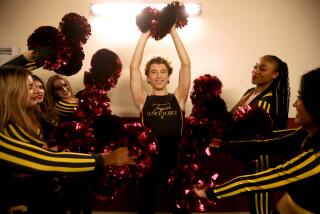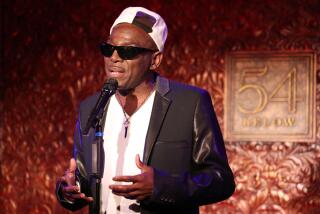Petronio’s Program of Danger, Heroism
In his career as dancer and choreographer, Stephen Petronio has sought and won both respect and notoriety--respect as the first male in the company of postmodern pioneer Trisha Brown, notoriety for his erotic duets-in-corsets opposite obnoxious British ballet provocateur Michael Clark.
The Los Angeles debut of Petronio’s heroic nine-member company Friday at Schoenberg Hall, UCLA, courted similar extremes, generating admiration for the unique power and complexity of his choreography versus an eye-rolling “Oh, brother!” for costumes desperate to highlight and reveal crotches, breasts and buttocks.
Beyond their juvenile shock quotient, those costumes by New York fashion designer Manolo featured loose fringe and gauze that created comet tails behind the dancers, emphasizing the intense velocity of their movement in the two outer pieces on the program, “Drawn That Way” (1996) and “Lareigne” (1995). In the central quartet, “#4” (1996), with the dancers arranged in a line up a narrow staircase, their near-nudity highlighted the sculptural richness of their restless, isolated positional shifts.
“Drawn That Way” and “Lareigne” each began with male solos-in-underwear in which the dancers dramatized and projected the roundness of torsos and limbs through twisty rotations that included everything from head-lolling to full-body swirls. However, in “Drawn That Way,” Gerald Casel coiled and stretched with fierce deliberation, while in “Lareigne,” Ori Flomin hurled himself headfirst into one off-balance predicament after another.
When the group dancing began, “Drawn That Way” continued to be absorbed with the concept of control--especially architectural patterning--and “Lareigne” continued to explore an almost anarchic freedom: the experience of being swept up in the moment.
After using Suede’s “Sleeping Pills” for the opening solo in “Drawn That Way,” Petronio switched to the nostalgic neoclassic formality of Andy Teirstein’s Rhapsody for Boy Soprano and Strings, music that helped him stay focused on structural issues. With major solos for himself and Kristen Borg punctuating the ensembles, the piece cultivated an ideal of clarity and exactitude even in its high-speed whirlwind passages.
However, the most memorable section may have been the enigmatic duet for Casel and Jessica Meeker, always dancing close to one another, sharing the same motifs, but deeply into private thoughts and feelings; never touching, never acknowledging any connection.
Ideas about counterpoint and spatial design yielded to a breakneck ferocity in “Lareigne,” which boasted suitably engulfing accompaniment: initially the Stranglers’ “No More Heroes” and then a propulsive percussive score by David Linton. Petronio played a dangerous game here--demanding wind-whipped speed, fearless plunges out of balance and limitless stamina. And his company responded brilliantly.
Beyond its impact as a showpiece, “Lareigne” conveyed a sense of desperate animation, of dancing on the edge, of end-of-the-century apocalypse, perhaps--an impression nailed down by the passage in which nobody danced at all but remained focused on something terrifying in the wings, something that left them too paralyzed to run away.
Besides the dancers mentioned, the company included Steven Fetherhuff, Kimberly Olson and Tony Ramos. Diamanda Galas’ recording of “Balm and Gilead” accompanied “#4.” All music was on tape.
More to Read
The biggest entertainment stories
Get our big stories about Hollywood, film, television, music, arts, culture and more right in your inbox as soon as they publish.
You may occasionally receive promotional content from the Los Angeles Times.










